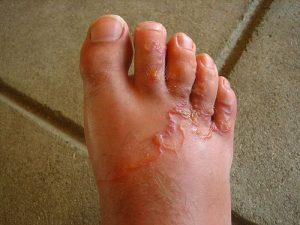Amy, Sorenne and I were walking around Nouvea, New Caledonia this morning, and passed a sushi shop.
I said, no, I don’t eat raw fish, I’m not into worms.
 If it’s frozen at sea it should control the worms, but that a long supply loop and I got enough problems.
If it’s frozen at sea it should control the worms, but that a long supply loop and I got enough problems.
Sorenne said, why would worms live inside us.
I started on an intro microbiology talk, but she soon became more interested in the next shop, despite my efforts to make it sound gross.
Maybe this story from today’s N.Y. Times by Laura Beil will help.
Millions of American children have been exposed to a parasite that could interfere with their breathing, liver function, eyesight and even intelligence. Yet few scientists have studied the infection in the United States, and most doctors are unaware of it.
The parasites, roundworms of the genus Toxocara, live in the intestines of cats and dogs, especially strays. Microscopic eggs from Toxocara are shed in the animals’ feces, contaminating yards, playgrounds and sandboxes.
These infectious particles cling to the hands of children playing outside. Once swallowed, the eggs soon hatch, releasing larvae that wriggle through the body and, evidence suggests, may even reach the brain, compromising learning and cognition.
The Centers for Disease Control and Prevention periodically tracks positive tests for Toxocara through the National Health and Nutrition Examination Survey. The latest report, published in September in the journal Clinical Infectious Diseases, estimated that about 5 percent of the United States population — or about 16 million people — carry Toxocara antibodies in their blood, a sign they have ingested the eggs.
But the risk is not evenly shared: Poor and minority populations are more often exposed. The rate among African Americans was almost 7 percent, according to the C.D.C. Among people living below the poverty line, the infection rate was 10 percent.
The odds of a positive test rise with age, but it’s unknown whether this reflects recent infections or simply an accumulation of antibodies from past encounters.
Dr. Peter Hotez, dean of the National School of Tropical Medicine at Baylor College of Medicine in Houston, calls Toxocara both one of the most common parasites in the country and arguably the most neglected.
 “We know in some cases it is linked to lower intelligence and epilepsy,” he said. “So if you were to look at disadvantaged kids living in poverty who are also doing lower on tests of school performance, what percentage of that can be attributed to this worm?”
“We know in some cases it is linked to lower intelligence and epilepsy,” he said. “So if you were to look at disadvantaged kids living in poverty who are also doing lower on tests of school performance, what percentage of that can be attributed to this worm?”
While much is still unknown, “there’s enough here to warrant doing a major study on a large number of children.”
At the moment, research into Toxocara among Americans is so lacking that the National Institutes of Health funding website lists no grants to study it. Even many of the most basic questions are unanswered, including how often ingested eggs progress to full-blown infection.
Among the country’s overlooked parasitic infections, “Toxocara is probably the one that affects the broadest range of people,” said Sue Montgomery, lead of the epidemiology team at the parasitic diseases branch of the C.D.C. “Dogs and cats are everywhere. Many of them may carry the parasites.”
Studies indicate that owned pets who receive regular veterinary care rarely carry Toxocara. Poorer neighborhoods bear a disproportionate share of strays. In one survey, 8,700 unowned dogs were said to be roaming parts of Dallas.
A survey of New York City playgrounds, presented at a medical conference last year, sampled 21 parks across the city. Toxocara eggs were found in nine parks. Three quarters of samples taken in the Bronx contained eggs in the larval stage, which are more infectious. No parks in Manhattan had eggs with larvae.
